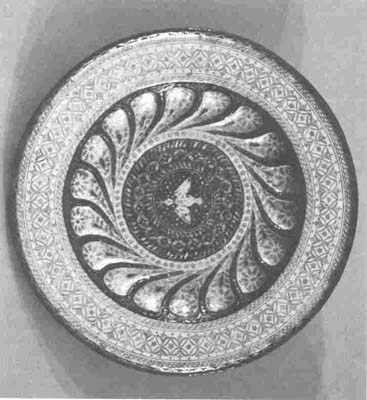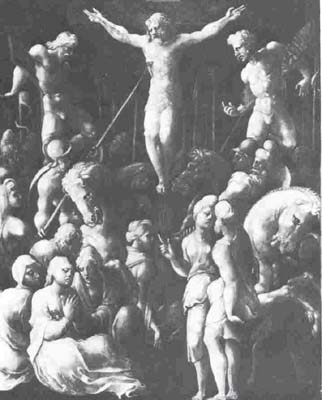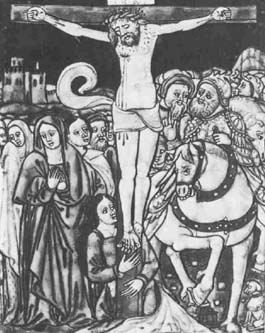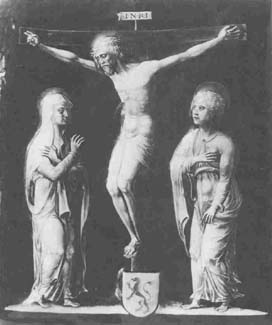
Annual Bulletin 6, 1982-1983
Home
Français
Introduction
History
Annual Index
Author &
Subject
Credits
Contact






Four Sixteenth-Century Painted Enamels
by Philippe Verdier
Article en français
Pages 1 | 2
| 3 | 4
| 5
The National Gallery of Canada's collection of Renaissance decorative art has been enriched
by the acquisition of four painted enamels: one Venetian plate and three
Limoges pieces, comprising a Crucifixion scene and a pair of candlesticks.
These works give an excellent idea of the evolution of painted enamelware
in the sixteenth century and the variety of copper objects on which painted
enamel was used as decoration.
Venetian plate, circa 1500 (1) (fig. 1)
The central medallion portrays a creamy-white dove painted on a blue and green enamel
background, scattered with gilt stars, a festoon and two palmette friezes.
The medallion is bordered by eighteen gadroons forming a spiral. These
are painted white and decorated with gilt palmettes. The border of the
plate has a double guilloche and a combination of four-petalled rosettes
and corollas. The reverse is enamelled in sapphire blue, and strewn with
stars. The triple, flaming dart in the beak of the dove, a symbol of the
Holy Spirit, suggests that the plate was a liturgical vessel. Venetian
enamels decorate not only special dishes for the table or sideboard, but
also reliquaries, candlesticks, and lamps for altar service.(2)
The gadrooning on Venetian enamelware reproduces a structural
element of the tazze and coppe costolate of Murano glassware,
which was inspired by the fluted glassware of the Middle East and the early
models for the latter - Sassanian metalwork. (3) Gadrooning may also be found
on the Venetian plates in the Wadsworth Atheneum and the Martin D'Arcy
Gallery of Art at Loyola University, Chicago. (4) The gilt motifs on white,
green, or blue enamel imitated the backgrounds of Venetian translucent
enamels which, applied to fine metalwork, were popular in the Alpine region
north of Venice in the second half of the fifteenth century. (5)
Crucifixion, Limoges, mid-sixteenth century, (6)
Jean III Pénicaud? (fig. 2)
This plaque, enamelled in grisaille, was probably executed in the studio of Jean
II Pénicaud. There are works signed by him from 1531-1532 to 1549,
and perhaps by his son, referred to as "Pénicaud the enameller"
in documents, and called "Jean III" by nineteenth-century enamelware
historians. (7)
Toward the end of the 1530s, enamel in grisaille began to compete in Limoges
with coloured enamels. (8) This reflected a certain taste throughout Europe
at that time, which showed up particularly in the somberness of colours
in clothing fashions, as in Spain. The grisaille method underlines the
prevailing practice among enamellers to imitate engravings, and the influence
of engraving techniques. At the forefront was the technique of "shaving" or indenting, using a graver or small mallet, on a black background
previously hardened in an oven, and into which the enameller ground the
white enamel model in layers of varying opaqueness. It was through engraving
that Limoges enamellers were introduced to Florentine Mannerism, which
had just been brought to the French court at Fontainebleau by Rosso and
Primaticcio. Leonard Limousin, who did grisaille enamels, was presented
at Fontainebleau by Jean de Langeac, Bishop of Limoges from 1532 to 1541. (9)
The Mannerist invasion had been prepared and was reinforced at Limoges
by the spread of engravings by Marcantonio and artists of Raphael's school.
The sfumato, usked skilfully by the author of the Crucifixion plaque, is in keeping with the terrible darkness which fell on Golgotha
after the centurion pierced the dead Christ's side with a lance. Light
is shining on the spearheads, banners, a halberd, a helmet, the face of
an old man in the background, and the heads of the horses whinnying on
either side of the crucified Christ's legs. Christ's face, with its almost
Michelangelesque musculature, has become serene. His forefinger,
middle finger and thumb are still extended in blessing. From the nail
wounds on his palms, blood runs down his forearms. Beneath his feet, the
wood grain in the cross blends with the trickles of blood. Mary Magdalene,
with her thick, flat braids, is stupefied with grief at the foot of the
cross. In contrast to Crucifixion iconography beginning in the fifteenth
century and the Crucifixions enamelled in Limoges, she is not clasping
the cross (fig. 3). The Virgin, shown very young and without a veil {the
contours of her breasts are visible under her clinging robe), has collapsed
on the ground. The holy women and Saint John are assisting her. On the
other side, a young woman is pointing out Christ to a man with a Pontormesque
silhouette; the man's face is half hidden and his turban identifies him
as a Jew. Could this be a reminder and a very original interpretation of
the "dispute," traditional in medieval art, between the Church and Synagogue
at the foot of the cross? To the right, a horseman, in a Phrygian cap,
is hurrying from the scene; the horse is rearing and the man is looking
back toward Christ. The head of the repentant thief is hanging toward Christ;
the unrepentant thief is making a gesture of revolt, perhaps to indicate
that the Father did not come down to deliver his Son.
The work, which is attributed here to the studio of Jean II Pénicaud
- or, in his school, to Jean III Pénicaud - is unsigned, and the copper
on the reverse is not stamped with the mark used for work executed by Jean
II or under his direction. (10) Jean II Pénicaud's talent as a draftsman
can be seen in the enamel Crucifixion executed in grisaille, bearing his
initials, in the Hermitage Museum in Leningrad (11) (fig. 4) .The cross in
the Hermitage enamel is narrow and the horizontal beam arched, as if
in keeping with the Pange Lingua, the hymn in the Good Friday liturgy:
"Lofty tree, bend clown thy branches, relax the native tension of that all too-rigid wood." Christ's hand on the side of the Virgin is the only
one portrayed in the gesture of blessing. From Christ's chest, blood spurts
toward the Virgin. There is a shining halo around the crown of thorns.
The shortness of the legs of the Virgin and Saint John are among the most
notable mannerisms of the work.
Next Page | coloured-enamel
Crucifixion by Jean II
1 |
2
| 3 | 4
| 5
Annual Index | Author & Subject | Credits | Contact
This digital collection
was produced under contract to Canada's Digital Collections program,
Industry Canada.
"Digital
Collections Program, Copyright
© National Gallery of
Canada 2001"